Abstract
The ability of auxin to alter gene transcription in pea (Pisum sativum L.) stem tissues has been investigated by means of DNA/RNA hybridization-competition techniques. In order to obtain reproducible hybridization with total nucleic acid preparations from plants it was found necessary to remove interfering substances, probably polysaccharides; this was accomplished by methoxyethanol extraction and precipitation with cetyltrimethylammonium bromide. When purified in this fashion, plant nucleic acids could be made to form hybrids which showed both species specificity and high thermal stability.
No change in hybridizable RNA of stem sections in response to auxin could be detected over a 2- to 24-hour period, regardless of the auxin level employed. In contrast, when large doses of auxin were applied to intact pea seedlings, definite changes in the hybridizable RNA of stem tissue were detected both 8 and 24 hours after treatment. Many of the 2,4-D-induced species of RNA which were present at 24 hours were also present at 8 hours. Sections apparently lack a factor needed for the manifestation of the auxin effect on RNA synthesis.
Since the hybridization assay employed does not measure all cellular RNA, it is still possible that certain RNA species may be synthesized in sections in response to auxin. However, the auxin promotion of cell elongation in such sections is clearly not associated with changes in hybridizable RNA such as have been reported for several hormonal responses in animal systems.
Full text
PDF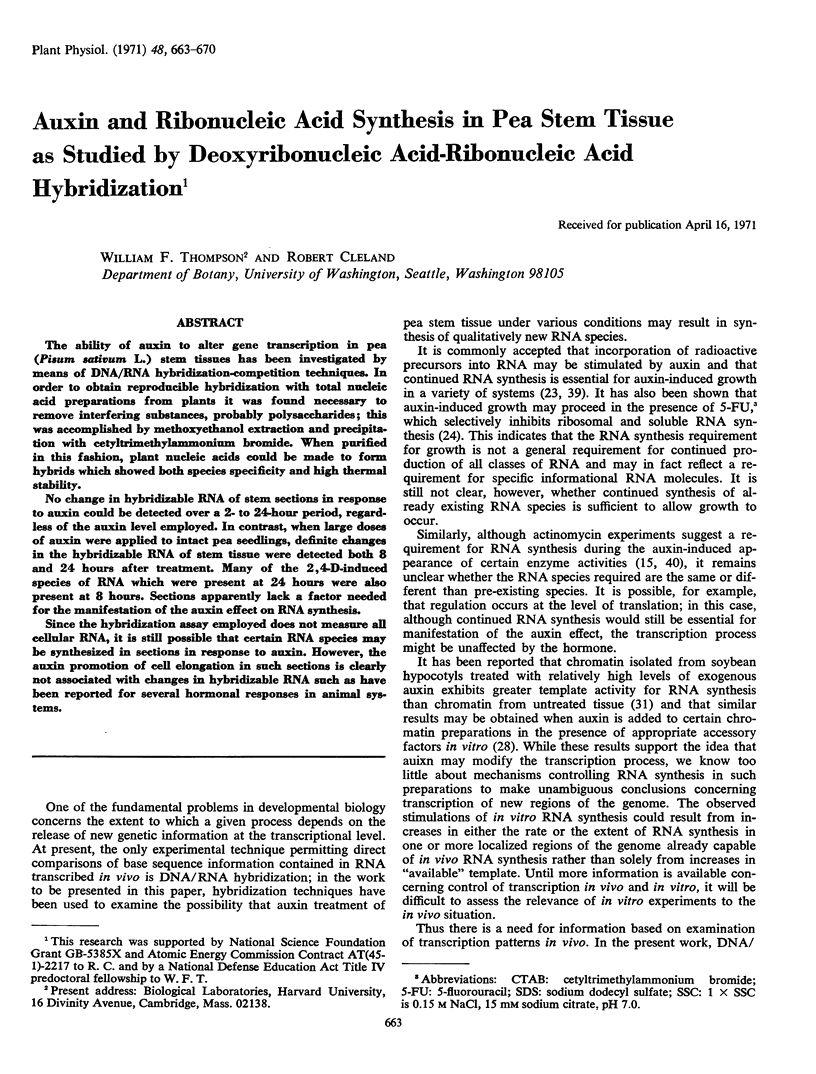
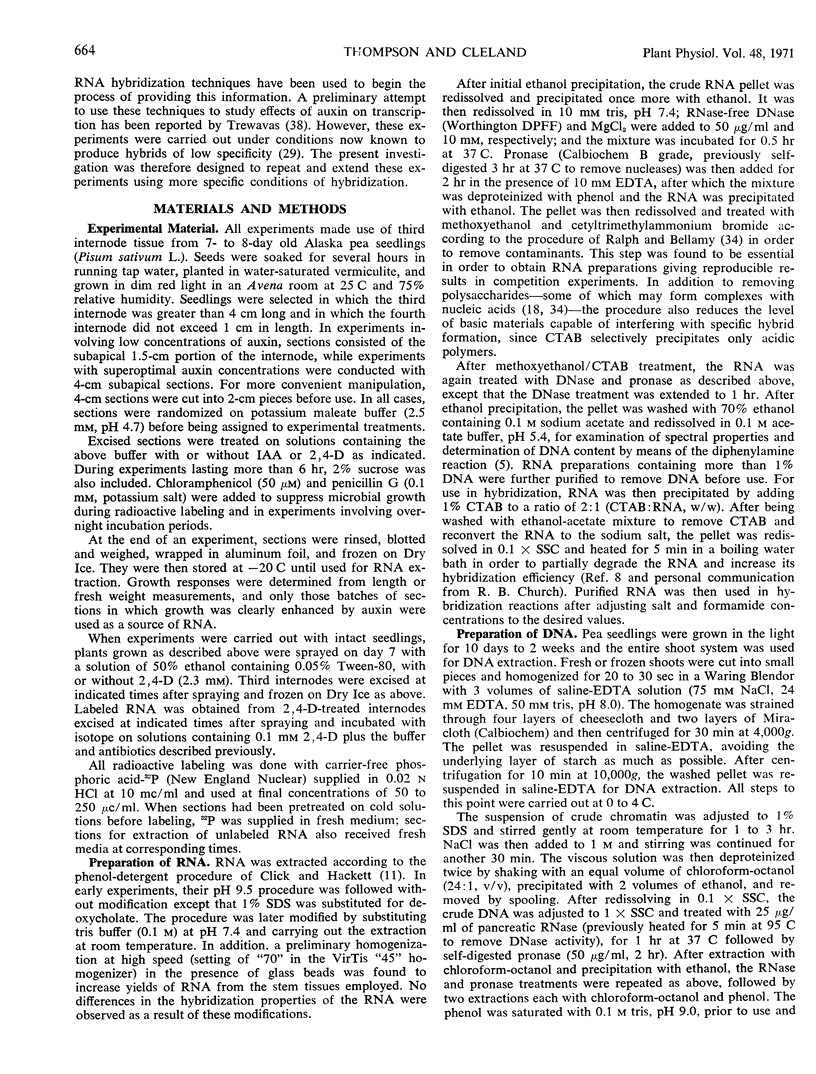
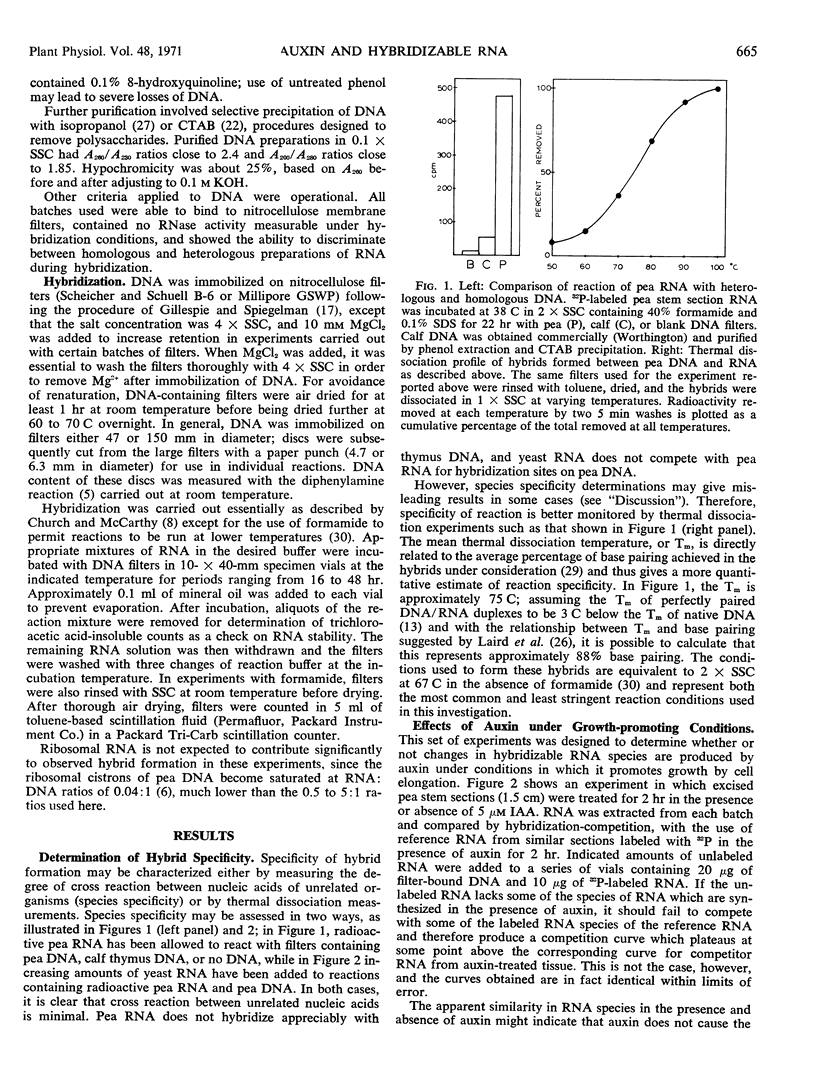
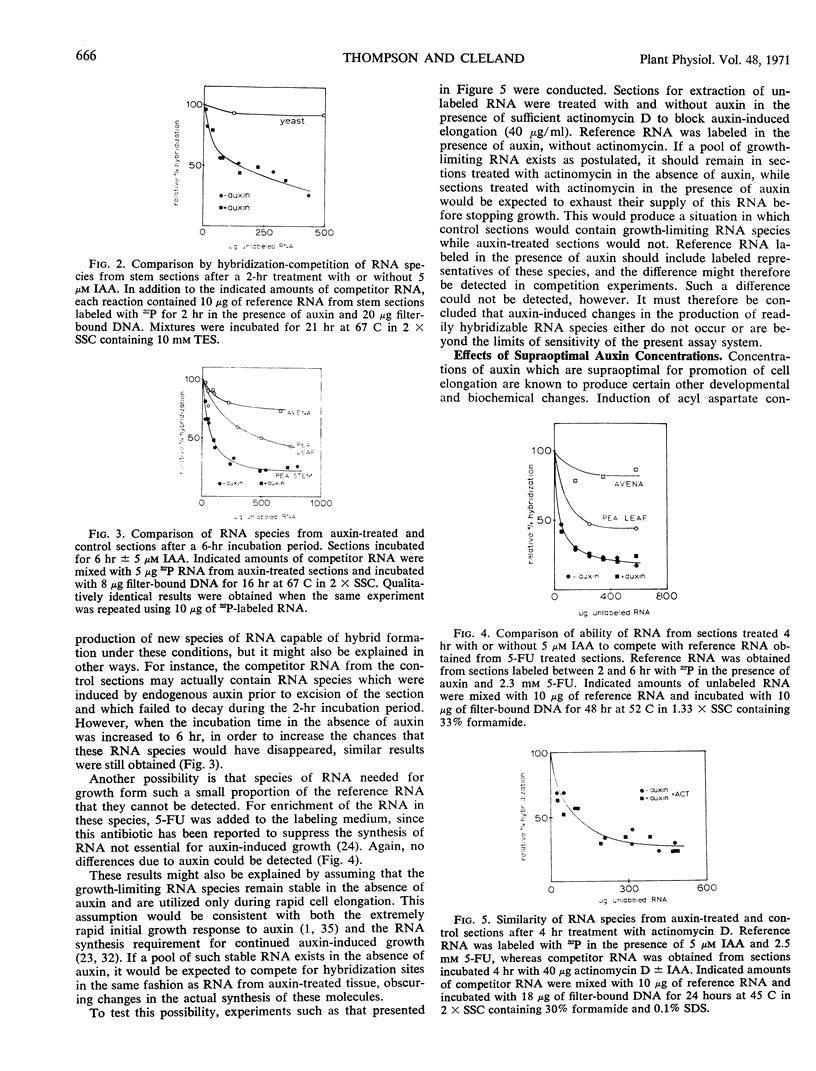
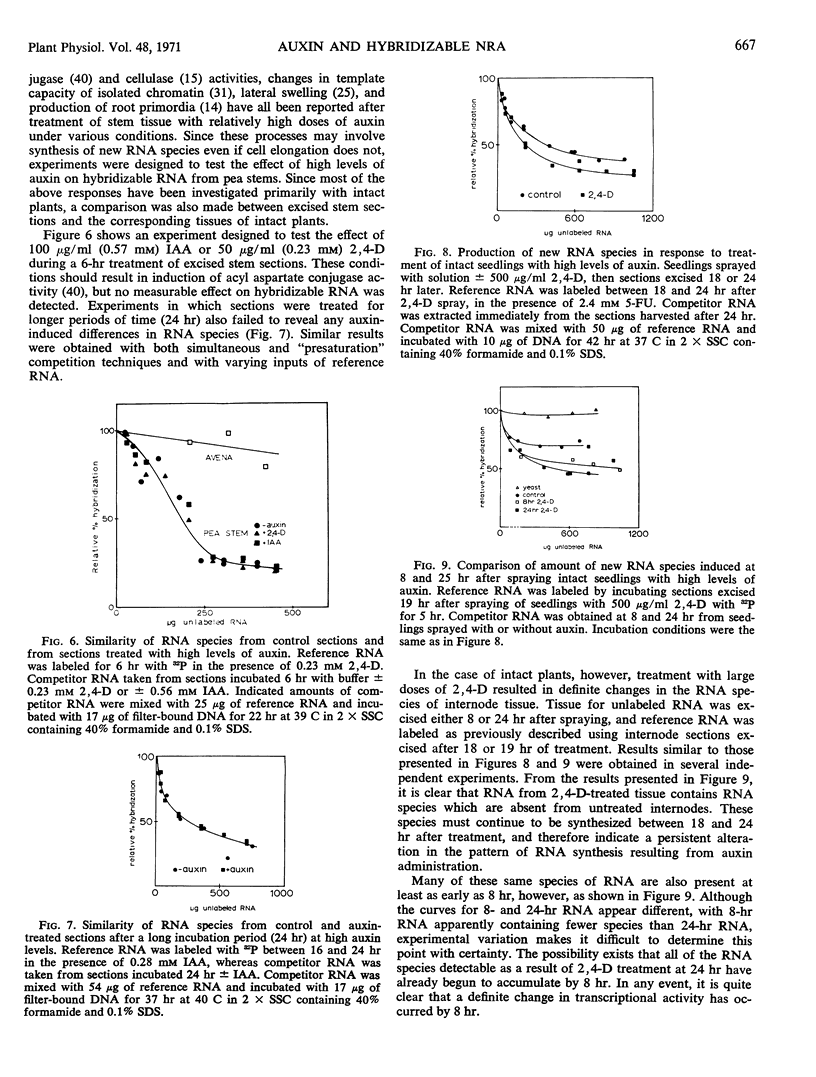
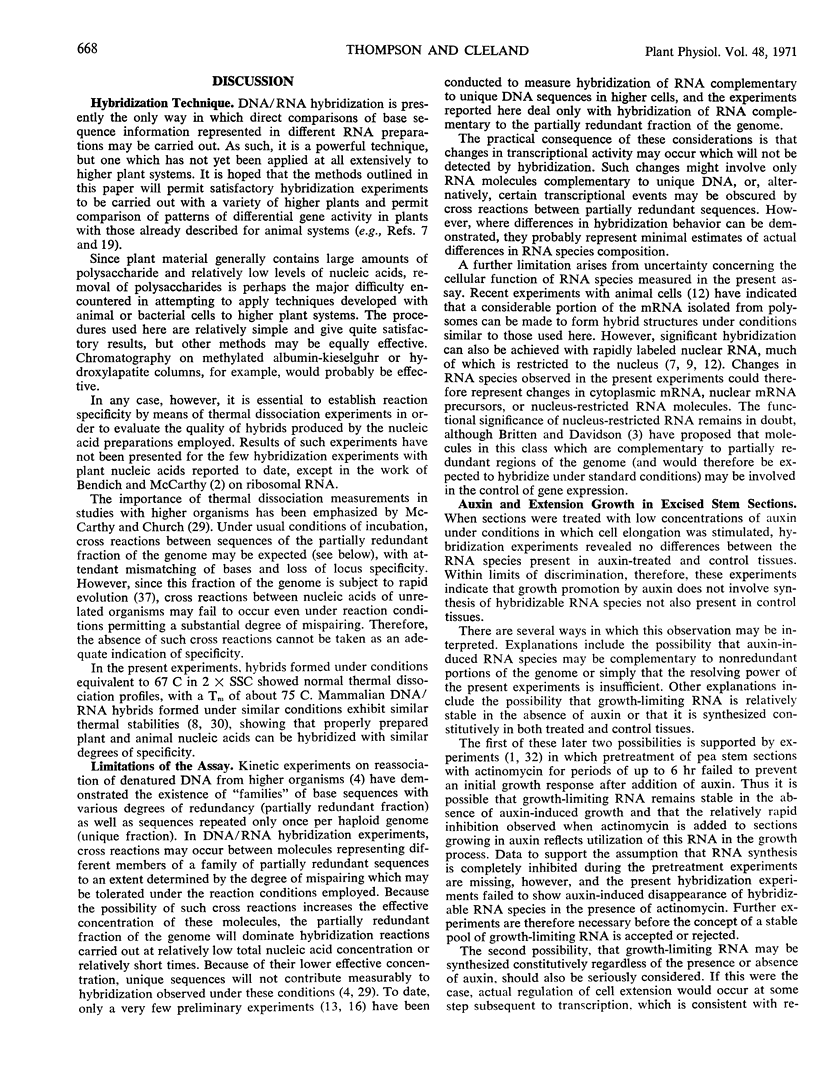
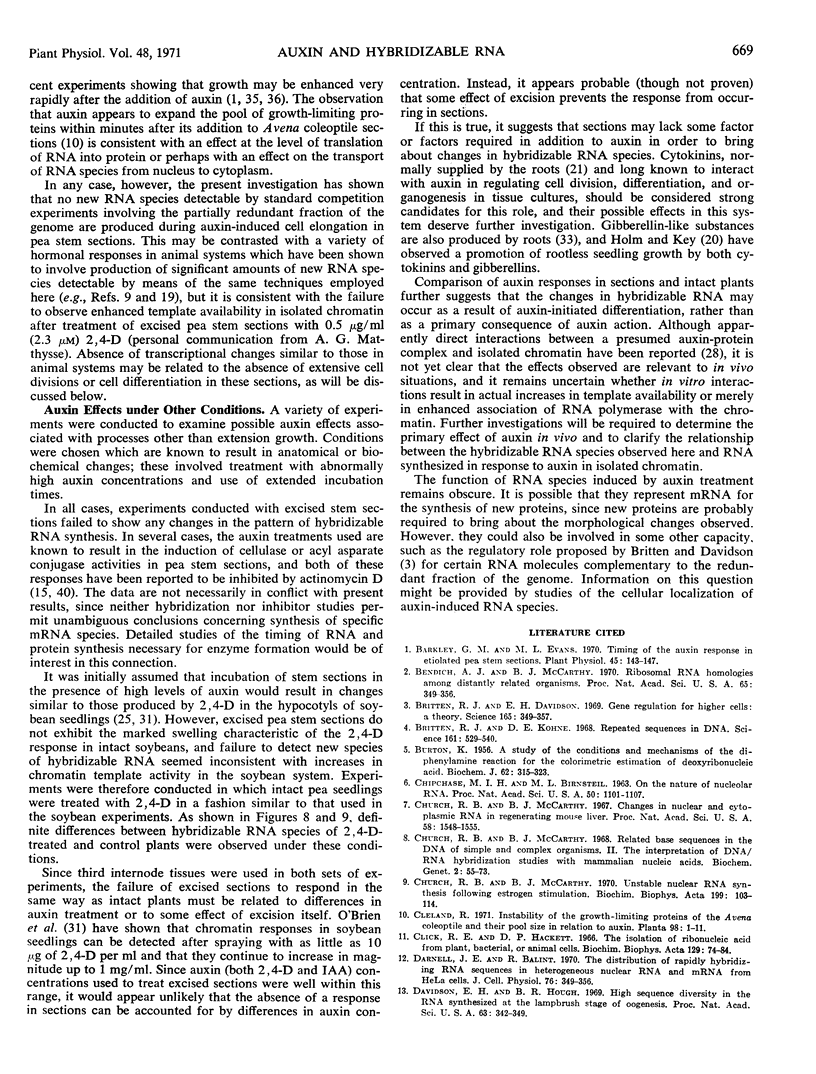
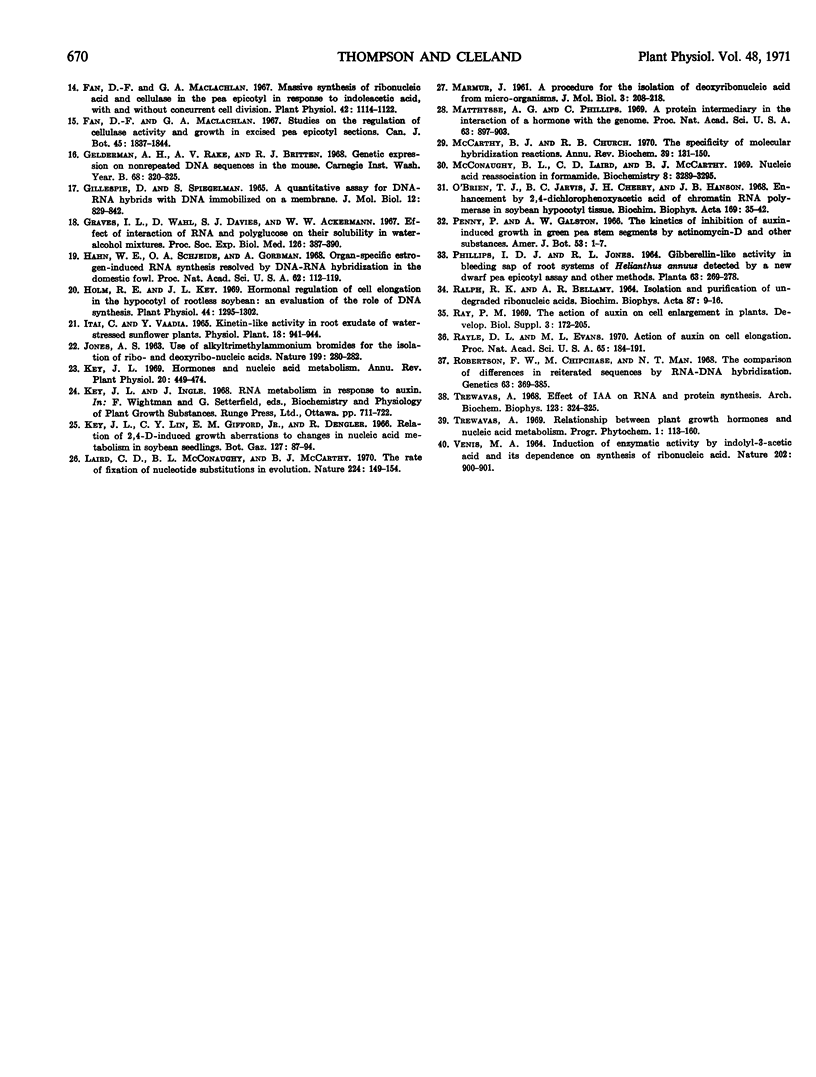
Selected References
These references are in PubMed. This may not be the complete list of references from this article.
- BURTON K. A study of the conditions and mechanism of the diphenylamine reaction for the colorimetric estimation of deoxyribonucleic acid. Biochem J. 1956 Feb;62(2):315–323. doi: 10.1042/bj0620315. [DOI] [PMC free article] [PubMed] [Google Scholar]
- Barkley G. M., Evans M. L. Timing of the auxin response in etiolated pea stem sections. Plant Physiol. 1970 Feb;45(2):143–147. doi: 10.1104/pp.45.2.143. [DOI] [PMC free article] [PubMed] [Google Scholar]
- Bendich A. J., McCarthy B. J. Ribosomal RNA homologies among distantly related organisms. Proc Natl Acad Sci U S A. 1970 Feb;65(2):349–356. doi: 10.1073/pnas.65.2.349. [DOI] [PMC free article] [PubMed] [Google Scholar]
- Britten R. J., Davidson E. H. Gene regulation for higher cells: a theory. Science. 1969 Jul 25;165(3891):349–357. doi: 10.1126/science.165.3891.349. [DOI] [PubMed] [Google Scholar]
- Britten R. J., Kohne D. E. Repeated sequences in DNA. Hundreds of thousands of copies of DNA sequences have been incorporated into the genomes of higher organisms. Science. 1968 Aug 9;161(3841):529–540. doi: 10.1126/science.161.3841.529. [DOI] [PubMed] [Google Scholar]
- CHIPCHASE M. I., BIRNSTIEL M. L. ON THE NATURE OF NUCLEOLAR RNA. Proc Natl Acad Sci U S A. 1963 Dec;50:1101–1107. doi: 10.1073/pnas.50.6.1101. [DOI] [PMC free article] [PubMed] [Google Scholar]
- Church R. B., McCarthy B. J. Related base sequences in the DNA of simple and complex organisms. II. The interpretation of DNA-RNA hybridization studies with mammalian nucleic acids. Biochem Genet. 1968 Jun;2(1):55–73. doi: 10.1007/BF01458451. [DOI] [PubMed] [Google Scholar]
- Church R. B., McCarthy B. J. Unstable nuclear RNA synthesis following estrogen stimulation. Biochim Biophys Acta. 1970 Jan 21;199(1):103–114. doi: 10.1016/0005-2787(70)90699-4. [DOI] [PubMed] [Google Scholar]
- Church R., McCarthy B. J. Changes in nuclear and cytoplasmic RNA in regenerating mouse liver. Proc Natl Acad Sci U S A. 1967 Oct;58(4):1548–1555. doi: 10.1073/pnas.58.4.1548. [DOI] [PMC free article] [PubMed] [Google Scholar]
- Darnell J. E., Balint R. The distribution of rapidly hybridizing RNA sequences in heterogeneous nuclear RNA and mRNA from HeLa cells. J Cell Physiol. 1970 Dec;76(3):349–356. doi: 10.1002/jcp.1040760312. [DOI] [PubMed] [Google Scholar]
- Davidson E. H., Hough B. R. High sequence diversity in the RNA synthesized at the lampbrush stage of oögenesis. Proc Natl Acad Sci U S A. 1969 Jun;63(2):342–349. doi: 10.1073/pnas.63.2.342. [DOI] [PMC free article] [PubMed] [Google Scholar]
- Fan D. F., Maclachlan G. A. Massive synthesis of ribonucleic Acid and cellulase in the pea epicotyl in response to indoleacetic Acid, with and without concurrent cell division. Plant Physiol. 1967 Aug;42(8):1114–1122. doi: 10.1104/pp.42.8.1114. [DOI] [PMC free article] [PubMed] [Google Scholar]
- Gillespie D., Spiegelman S. A quantitative assay for DNA-RNA hybrids with DNA immobilized on a membrane. J Mol Biol. 1965 Jul;12(3):829–842. doi: 10.1016/s0022-2836(65)80331-x. [DOI] [PubMed] [Google Scholar]
- Graves I. L., Wahl D., Davies S. J., Ackermann W. W. Effect of interaction of RNA and polyglucose on their solubility in water-alcohol mixtures. Proc Soc Exp Biol Med. 1967 Nov;126(2):387–390. doi: 10.3181/00379727-126-32453. [DOI] [PubMed] [Google Scholar]
- Hahn W. E., Schjeide O. A., Gorbman A. Organ-specific estrogen-induced RNA synthesis resolved by DNA-RNA hybridization in the domestic fowl. Proc Natl Acad Sci U S A. 1969 Jan;62(1):112–119. doi: 10.1073/pnas.62.1.112. [DOI] [PMC free article] [PubMed] [Google Scholar]
- Holm R. E., Key J. L. Hormonal regulation of cell elongation in the hypocotyl of rootless soybean: an evaluation of the role of DNA synthesis. Plant Physiol. 1969 Sep;44(9):1295–1302. doi: 10.1104/pp.44.9.1295. [DOI] [PMC free article] [PubMed] [Google Scholar]
- JONES A. S. USE OF ALKYLTRIMETHYLAMMONIUM BROMIDES FOR THE ISOLATION OF RIBO- AND DESOXYRIBO-NUCLEIC ACIDS. Nature. 1963 Jul 20;199:280–282. doi: 10.1038/199280b0. [DOI] [PubMed] [Google Scholar]
- Laird C. D., McConaughy B. L., McCarthy B. J. Rate of fixation of nucleotide substitutions in evolution. Nature. 1969 Oct 11;224(5215):149–154. doi: 10.1038/224149a0. [DOI] [PubMed] [Google Scholar]
- Matthysse A. G., Phillips C. A protein intermediary in the interaction of a hormone with the genome. Proc Natl Acad Sci U S A. 1969 Jul;63(3):897–903. doi: 10.1073/pnas.63.3.897. [DOI] [PMC free article] [PubMed] [Google Scholar]
- McCarthy B. J., Church R. B. The specificity of molecular hybridization reactions. Annu Rev Biochem. 1970;39:131–150. doi: 10.1146/annurev.bi.39.070170.001023. [DOI] [PubMed] [Google Scholar]
- McConaughy B. L., Laird C. D., McCarthy B. J. Nucleic acid reassociation in formamide. Biochemistry. 1969 Aug;8(8):3289–3295. doi: 10.1021/bi00836a024. [DOI] [PubMed] [Google Scholar]
- Penny P., Galston A. W. The kinetics of inhibition of auxin-induced growth in green pea stem segments by actinomycin D and other substances. Am J Bot. 1966 Jan;53(1):1–7. [PubMed] [Google Scholar]
- RALPH R. K., BELLAMY A. R. ISOLATION AND PURIFICATION OF UNDEGRADED RIBONUCLEIC ACIDS. Biochim Biophys Acta. 1964 May 18;87:9–16. doi: 10.1016/0926-6550(64)90041-6. [DOI] [PubMed] [Google Scholar]
- Rayle D. L., Evans M. L., Hertel R. Action of auxin on cell elongation. Proc Natl Acad Sci U S A. 1970 Jan;65(1):184–191. doi: 10.1073/pnas.65.1.184. [DOI] [PMC free article] [PubMed] [Google Scholar]
- Robertson F. W., Chipchase M., Mân N. T. The comparison of differences in reiterated sequences by RNA-DNA hybridisation. Genetics. 1969 Oct;63(2):369–385. doi: 10.1093/genetics/63.2.369. [DOI] [PMC free article] [PubMed] [Google Scholar]
- Trewavas A. J. Effect of IAA on RNA and protein synthesis. Effects of 3-indolylacetic acid on the metabolism of ribonucleic acid and protein in etiolated subapical sections of Pisum sativum. Arch Biochem Biophys. 1968 Feb;123(2):324–335. doi: 10.1016/0003-9861(68)90142-2. [DOI] [PubMed] [Google Scholar]
- VENIS M. A. INDUCTION OF ENZYMATIC ACTIVITY BY INDOLYL-3-ACETIC ACID AND ITS DEPENDENCE ON SYNTHESIS OF RIBONUCLEIC ACID. Nature. 1964 May 30;202:900–901. doi: 10.1038/202900b0. [DOI] [PubMed] [Google Scholar]


